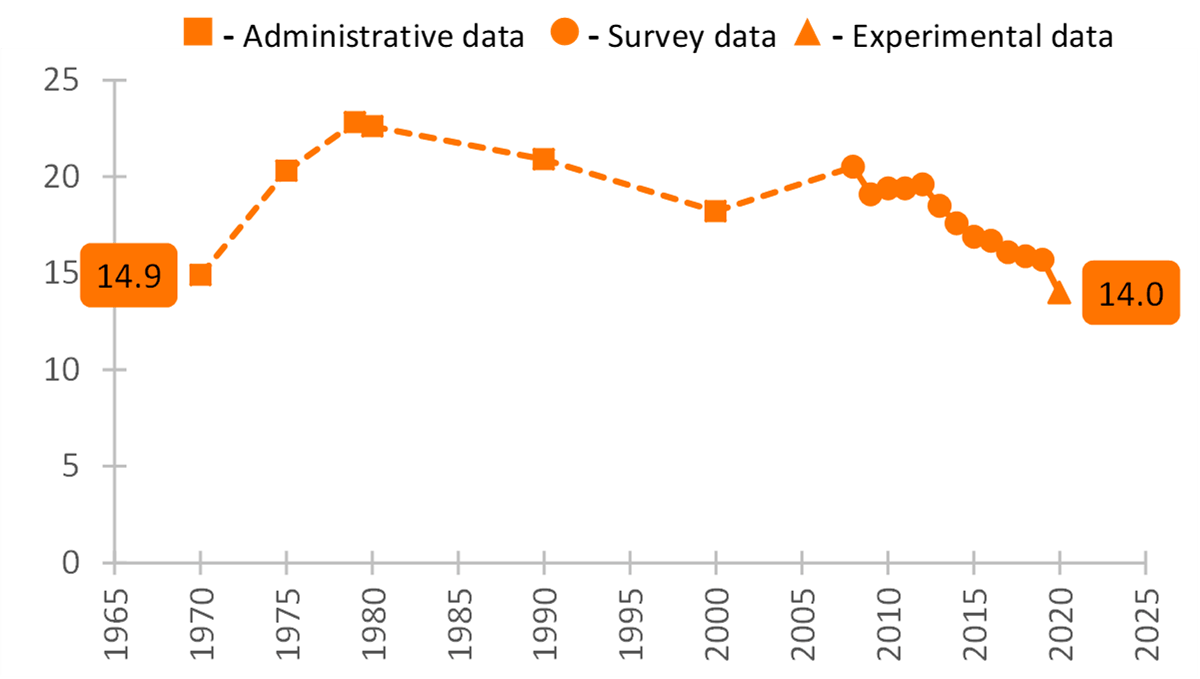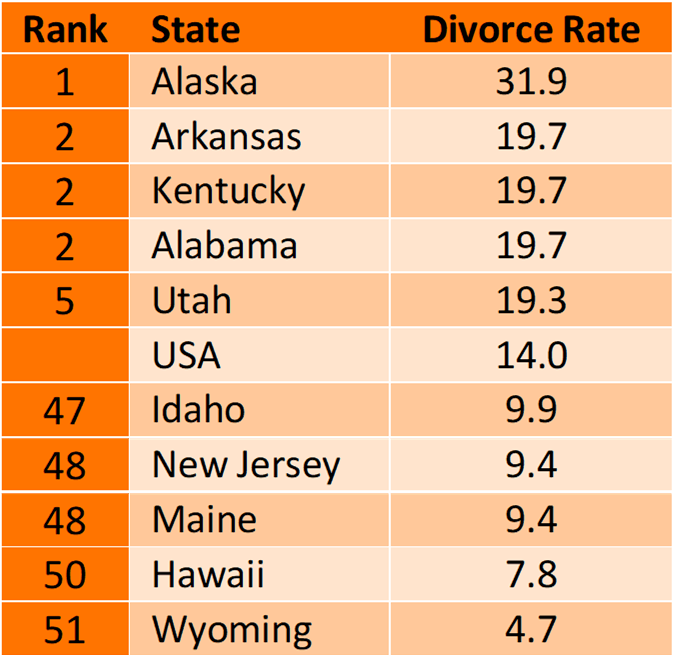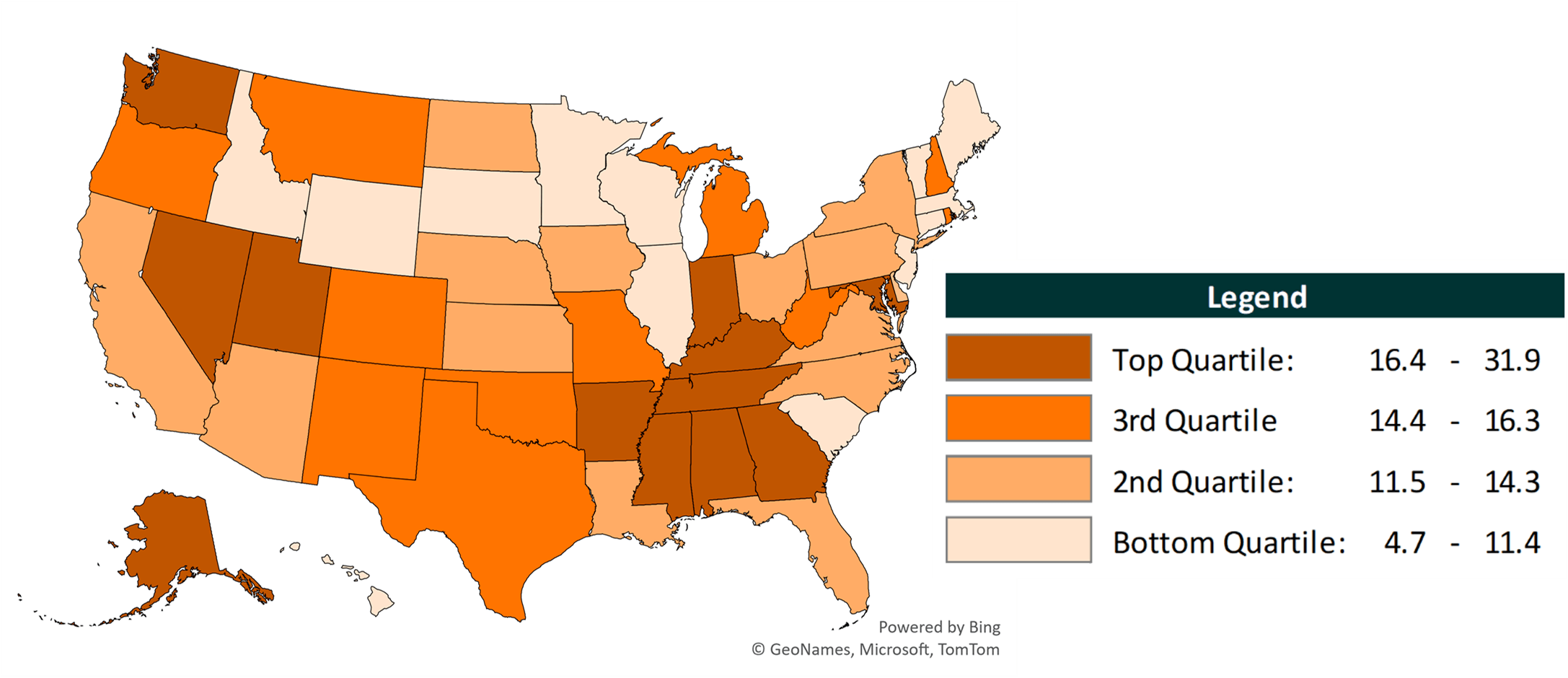Divorce Rate in the U.S.: Geographic Variation, 2020
Family Profile No. 08, 2022
Author: Krista K. Westrick-Payne
This Family Profile, an update to previous profiles on the divorce rate (FP-17-24; FP-18-21; FP-19-23; FP-20-25), depicts adjusted divorce rates for the nation and each state for 2020. Please note, the standard 2020 ACS 1-year data products will not be released due to the impact from the COVID-19 pandemic on data collection and data quality (for more information click here). As such, the estimates in this report for the year 2020 were derived from NCFMR analyses of ACS 1-year Experimental PUMS data. We estimated the number of divorces occurring in the last year among married women and describe geographic variation in the divorce rate. Because the standard 1-year estimates were not released, we do not include margins of error in the tables or figures as in prior profiles. For detailed information on the adjusted divorce rate from 2008-2020, see “Charting Marriage & Divorce in the U.S.: The Adjusted Divorce Rate” (Westrick-Payne, 2022).
U.S. Divorce Rate, 20201·
- The divorce rate continued its trend of decline with 14.0 divorces per 1,000 married women in 2020.
- Just under one million women (960,014) divorced in 2020.
Figure 1. Women’s Adjusted Divorce Rate, 1970-2020

1The divorce rate = [(number of women divorced in the past 12 months) / (number of women divorced in the past 12 months + number of currently married women)]*1000
Five Highest and Lowest Divorce Rates, 2020
- In 2020, Alaska held the top ranking for the highest divorce rate, with nearly 32 divorces per 1,000 married women.
- Wyoming had the lowest divorce rate in 2020, with nearly 5 marriages per 1,000 ending in divorce.
Figure 2. Women's Highest and Lowest Divorce Rates

State Rankings and Geographic Variation in Divorce Rates, 2020
- The 13 states with the highest divorce rates (making up the fourth/ top quartile) had rates of at least 16.4 divorces per 1,000 married women in 2020.
- The 13 states that experienced the lowest divorce rates (making up the first/ bottom quartile) had fewer than 11.4 divorces per 1,000 married women in 2020.
Figure 3. State-Level Women’s Adjusted Divorce Rate by Quartile, 2020

Figure 4. Geographic Variation of Women’s Adjusted Divorce Rate Among States, 2020

- Most states in the South (65%) and West (62%) had high divorce rates (in the third or fourth quartiles).
- Exceptions included North Carolina, Virginia, Florida, Louisiana, Delaware, Arizona, South Carolina, Idaho, Hawaii, and Wyoming.
- Most states in the Midwest (78%) and Northeast (75%) had low divorce rates (in the first or second quartiles).
- Exceptions included Rhode Island, Michigan, New Hampshire, Missouri, and Indiana.
Data Sources:
Clarke. S. C. (1995). Advanced report of final marriage statistics, 1989 and 1990. Monthly Vital Statistics Report, 42(12). National Center for Health Statistics. https://www.cdc.gov/nchs/data/mvsr/mv43_12.pdf
National Center for Health Statistics (1974). Summary report final marriage statistics, 1970. Monthly Vital Statistics Report, 23(2), Supp. 1. U.S. Department of Health, Education, and Welfare. https://www.cdc.gov/nchs/data/mvsr/supp/mv23_02s1acc.pdf
National Center for Health Statistics (1977). Advance report of final divorce statistics, 1975. Monthly Vital Statistics Report, 26(2), Supp. 2. U.S. Department of Health, Education, and Welfare. https://www.cdc.gov/nchs/data/mvsr/supp/mv26_02s2acc.pdf
National Center for Health Statistics (1983). Advance report of final marriage statistics, 1980. Monthly Vital Statistics Report, 32(5), Supp. U.S. Department of Health and Human Services. https://www.cdc.gov/nchs/data/mvsr/supp/mv32_05s.pdf
National Center for Health Statistics (2001). Births, marriages, divorces, and deaths: Provisional data for January-December 2000. National Vital Statistics Report, 49(6), Associated Table 3. Department of Health & Human Services, Center for Disease Control and Prevention. https://www.cdc.gov/nchs/data/nvsr/nvsr49/nvsr49_06.pdf
U.S. Census Bureau (2019). American Community Survey, 2019 1-Year Estimates [Table B12001]. https://data.census.gov/cedsci/table?q=B12001&lastDisplayedRow=18&table=B12001&tid=ACSDT1Y2018.B12001
U.S. Census Bureau (2019). American Community Survey, 2019 1-Year Estimates [Table B12503]. https://data.census.gov/cedsci/table?q=B12503&hidePreview=false&table=B12503&tid=ACSDT1Y2018.B12503&lastDisplayedRow=10
U.S. Census Bureau (2021). American Community Survey, 2020 1-year Experimental PUMS
References:
Allred, C. (2019). Divorce rate in the U.S.: Geographic variation, 2018. Family Profiles, FP-19-23. Bowling Green, OH: National Center for Family & Marriage Research. https://doi.org/10.25035/ncfmr/fp-18-23
Hemez, P. (2017). Divorce rate in the U.S.: Geographic variation, 2016. Family Profiles, FP-17-24. Bowling Green, OH: National Center for Family & Marriage Research. https://doi.org/10.25035/ncfmr/fp-17-24
Payne, K. K. (2018). Charting marriage and divorce in the U.S.: The adjusted divorce rate. Bowling Green, OH: National Center for Family & Marriage Research. https://doi.org/10.25035/ncfmr/adr-2008-2017
Schweizer, V. (2018). Divorce rate in the U.S.: Geographic variation, 2017. Family Profiles, FP-18-21. Bowling Green, OH: National Center for Family & Marriage Research. https://doi.org/10.25035/ncfmr/fp-18-21
Reynolds, L. (2020). Divorce rate in the U.S.: Geographic variation, 2019. Family Profiles, FP-20-25. Bowling Green, OH: National Center for Family & Marriage Research. https://doi.org/10.25035/ncfmr/fp-20-25
Suggested Citation:
Westrick-Payne, K. K. (2022). Divorce rate in the U.S.: Geographic variation, 2020. Family Profiles, FP-22-08. Bowling Green, OH: National Center for Family & Marriage Research. https://doi.org/10.25035/ncfmr/fp-22-08
Updated: 11/12/2025 09:54AM


